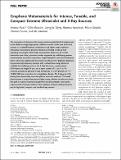| dc.contributor.author | Pizzi, Andrea | |
| dc.contributor.author | Rosolen, Gilles | |
| dc.contributor.author | Wong, Liang Jie | |
| dc.contributor.author | Ischebeck, Rasmus | |
| dc.contributor.author | Soljacic, Marin | |
| dc.contributor.author | Feurer, Thomas | |
| dc.contributor.author | Kaminer, Ido | |
| dc.date.accessioned | 2022-07-21T13:31:59Z | |
| dc.date.available | 2021-09-20T18:22:05Z | |
| dc.date.available | 2022-07-21T13:31:59Z | |
| dc.date.issued | 2019 | |
| dc.identifier.uri | https://hdl.handle.net/1721.1/132371.2 | |
| dc.description.abstract | © 2019 The Authors. Published by WILEY-VCH Verlag GmbH & Co. KGaA, Weinheim The interaction of electrons with strong electromagnetic fields is fundamental to the ability to design high-quality radiation sources. At the core of all such sources is a tradeoff between compactness and higher output radiation intensities. Conventional photonic devices are limited in size by their operating wavelength, which helps compactness at the cost of a small interaction area. Here, plasmonic modes supported by multilayer graphene metamaterials are shown to provide a larger interaction area with the electron beam, while also tapping into the extreme confinement of graphene plasmons to generate high-frequency photons with relatively low-energy electrons available from tabletop sources. For 5 MeV electrons, a metamaterial of 50 layers and length 50 µm, and a beam current of 1.7 µA, it is, for instance, possible to generate X-rays of intensity 1.5 × 107 photons sr−1 s−1 1%BW, 580 times more than for a single-layer design. The frequency of the driving laser dynamically tunes the photon emission spectrum. This work demonstrates a unique free-electron light source, wherein the electron mean free path in a given material is longer than the device length, relaxing the requirements of complex electron beam systems and potentially paving the way to high-yield, compact, and tunable X-ray sources. | en_US |
| dc.language.iso | en | |
| dc.publisher | Wiley | en_US |
| dc.relation.isversionof | 10.1002/ADVS.201901609 | en_US |
| dc.rights | Creative Commons Attribution 4.0 International license | en_US |
| dc.rights.uri | https://creativecommons.org/licenses/by/4.0/ | en_US |
| dc.source | Wiley | en_US |
| dc.title | Graphene Metamaterials for Intense, Tunable, and Compact Extreme Ultraviolet and X‐Ray Sources | en_US |
| dc.type | Article | en_US |
| dc.contributor.department | Massachusetts Institute of Technology. Department of Physics | en_US |
| dc.relation.journal | Advanced Science | en_US |
| dc.eprint.version | Final published version | en_US |
| dc.type.uri | http://purl.org/eprint/type/JournalArticle | en_US |
| eprint.status | http://purl.org/eprint/status/PeerReviewed | en_US |
| dc.date.updated | 2020-11-09T17:35:35Z | |
| dspace.orderedauthors | Pizzi, A; Rosolen, G; Wong, LJ; Ischebeck, R; Soljačić, M; Feurer, T; Kaminer, I | en_US |
| dspace.date.submission | 2020-11-09T17:35:42Z | |
| mit.journal.volume | 7 | en_US |
| mit.journal.issue | 1 | en_US |
| mit.license | PUBLISHER_CC | |
| mit.metadata.status | Publication Information Needed | en_US |
